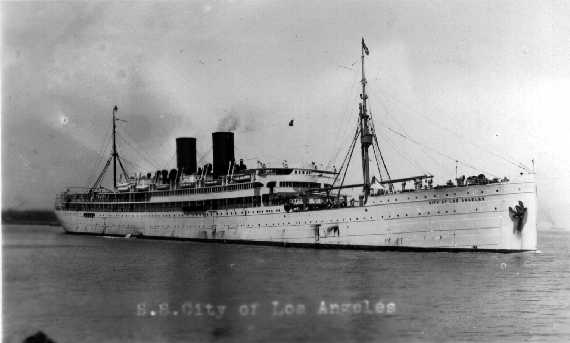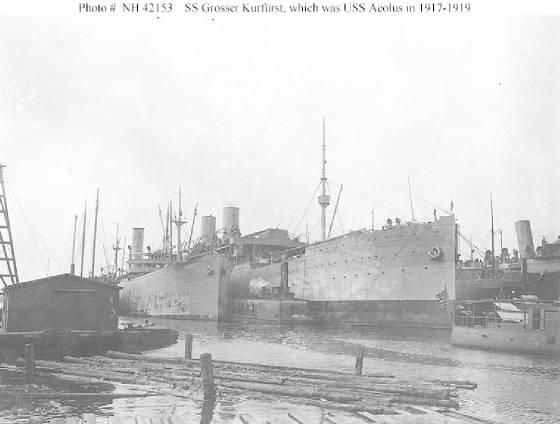|

|
| As City of Los Angeles |
Grosser Kurfurst alias Aeolus alias City of Los Angeles
By James Donahue
Launched at Danzig in 1899 for North German Lloyd Line, the passenger liner Grosser Kerfurst steamed
the oceans of the world under different flags and with three different names over a span of 37 years.
Seized by the United States during World War I, she served as a troop transport under the name Aeolus,
and then went to private ownership under the name City of Los Angeles and ran passenger service along the Pacific coast and
on trips to the Hawaiian Islands.
This ship was 560 feet in length, a formidable sized ship for its day. She had two funnels, two masts,
and was powered by twin screws so could reach a speed of 16 knots. It originally offered accommodations for 424 first class,
176 second class, and 1,211 third class passengers. The builders boasted that the ship offered "enormous carrying capacity"
and "excellent passenger accommodation" for all classes from first to steerage.
The Grosser Kurfurst made its maiden voyage to Asiatic and Australian ports and then began regularly
scheduled voyages in the spring of 1900 between Bremen, Germany and New York City. She was steaming for New York in 1914 when
the war started and because it was dangerous for German passenger ships to be on the high seas, she moored there until America
entered the war three years later.
At the start of America’s role in the war, customs agents boarded the Grosser Kurfurst along
with 30 other German and Austro-Hungarian ships and sent their crews to an internment camp on Ellis Island. Before this happened,
however, the sailors caused as much destruction as they could on the vessels, calculated to take time for repair.
The Navy earmarked the Grosser Kurfurst for service as a troop transport and sent her to the Navy
yard in New York for repair and refitting. She emerged in September, 1917, with a new name: Aeolus.

|
| Under German Flag |
The Aeolus made eight round trips between America and France, carrying troops into battle. There were
two incidents that occurred on these trips; a collision and an encounter with a German submarine.
While on its second voyage to France, Aeolus was traveling in convoy behind the transport Siboney.
When Siboney developed steering gear problems and dropped out of her place in the convoy, it threatened to collide with Aeolus.
The wheelsman on Aeolus altered course radically and this caused the Aeolus to collide with another ship in the convoy, the
Huron. No lives were lost but both ships were damaged enough they were forced to turn back to the U.S. for repair.
In August, 1918, while steaming from Brest for the United States, a lookout spotted the wake of a
submarine periscope about 6,000 yards off. The skipper of Aeolus ordered a course change, stood the crew to general quarters
and her three guns began firing. The guns continued firing at the area where the periscope was seen until the ship pulled
out of range. Because she could steam at 16 knots, the Aeolus could outrun a submerged German submarine.
After the armistice was signed on November 11, 1918, the Aeolus began participation in the big job
of transporting nearly 25,000 soldiers back home from the European battlefront. She made eight voyages transporting troops
back home before being decommissioned as a Navy ship.
From there, the vessel was turned over to the United States Shipping Board. She was brought to the
Baltimore Dry Dock and Ship Building Company in Maryland for general renovation. There the ship underwent massive refitting
and improvements at a cost of nearly $3 million. This included remodeled quarters, a new refrigeration system to allow cargoes
of frozen meat, a conversion of engines from coal to oil burners, and a new paint job that included a white superstructure.
Her new operators were the Munson Steamship Company. She sailed under that flag carrying passengers
and freight between South American ports until August, 1922, when she was sold to the Los Angeles Steamship Co. and renamed
City of Los Angeles.
There was another refitting and in September, 1922, she began a new route between the United States
and Hawaii. In 1931 the City of Los Angeles was involved in an experimental shore-to-ship mail flight. A Ford tri-motor followed
the ship out to see from Glendale and dropped a bag filled with 12,527 envelopes to the liner’s deck. It was a successful
drop and thus the liner brought the mail to Honolulu.
The City of Los Angeles remained on that route until 1937 when it was sold to Japanese interests and
scrapped.
|

